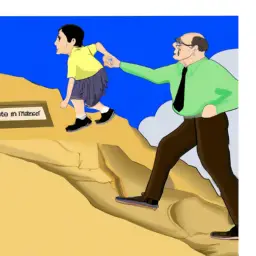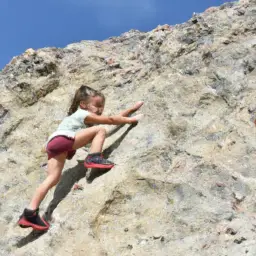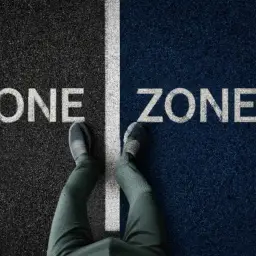Are you a teacher who wants to help your students develop a growth mindset and grit? You play a crucial role in fostering these qualities in your students, which are essential for their academic success and personal growth.
By encouraging a growth mindset and grit, you can help your students become more resilient, persistent, and motivated learners.
A growth mindset is the belief that intelligence and abilities can be developed through hard work, practice, and learning from mistakes. On the other hand, a fixed mindset is the belief that intelligence and abilities are fixed traits that cannot be changed.
Grit is the combination of passion and perseverance towards long-term goals, even in the face of obstacles and setbacks. Both growth mindset and grit are crucial for academic achievement and personal growth, and they can be developed through intentional teaching and learning practices.
In this article, we will explore the strategies and techniques that teachers can use to foster a growth mindset and grit in their students.
Key Takeaways
- Teachers play a crucial role in fostering growth mindset and grit in students through intentional teaching and learning practices.
- Creating a welcoming and supportive classroom environment is essential for students to feel safe and comfortable enough to learn and grow.
- Encouraging critical thinking skills by asking open-ended questions and integrating real-world challenges through problem-based learning can help develop grit in students.
- Celebrating progress, praising effort over innate ability, and encouraging students to set their own learning goals using SMART criteria are effective in promoting growth mindset.
Understanding the Importance of Growth Mindset and Grit
If you’re serious about helping your students achieve their goals and succeed in life, it’s crucial to understand the importance of a growth mindset and grit.
Research has shown that students who believe their abilities can be developed through hard work and dedication, rather than being fixed traits, are more likely to reach their full potential. This is what’s known as a growth mindset.
On the other hand, grit refers to the passion and perseverance towards long-term goals despite challenges and obstacles. Together, these two qualities can help students develop a resilient attitude towards learning and life in general.
Understanding mindset research is key to fostering a growth mindset in your students. It involves recognizing that intelligence and talent are not fixed traits, but rather can be developed through effort and persistence.
By emphasizing the importance of hard work and dedication, you can help your students develop a growth mindset and see challenges as opportunities for growth.
Additionally, fostering perseverance skills can help students develop grit and learn to overcome obstacles. By encouraging a ‘never give up’ attitude in your students, you can help them develop the resilience needed to achieve their goals and succeed in life.
Encouraging a Growth Mindset in the Classroom
When it comes to encouraging a growth mindset in the classroom, there are three important points to keep in mind.
First, emphasize the learning process over the end result.
Second, praise effort over innate ability.
And finally, provide constructive feedback that helps students understand how they can improve.
By focusing on these key areas, you can help your students develop a growth mindset that will serve them well throughout their academic and personal lives.
Emphasizing the Learning Process
As you’re emphasizing the learning process, you’ll see how much progress you can make with your grit development. Being active in your engagement and process-oriented in your approach is key to fostering a growth mindset. Here are some tips to help you emphasize the learning process:
-
Emphasize the importance of effort: Let your students know that their effort is what counts the most. Encourage them to try their best and praise them for their hard work.
-
Focus on the journey, not just the destination: Remind your students that learning is a process and that it’s important to enjoy the journey. Encourage them to reflect on what they’ve learned and how they’ve grown.
-
Embrace mistakes: Encourage your students to see mistakes as opportunities to learn and grow. Help them understand that it’s okay to make mistakes and that they can use them to improve.
-
Celebrate progress: Recognize and celebrate the progress your students make, no matter how small. Encourage them to continue working hard and remind them that progress takes time.
By emphasizing the learning process and encouraging active engagement and a process-oriented approach, you can help your students develop grit and a growth mindset. Remember to celebrate their progress and encourage them to keep working hard.
Praising Effort Over Ability
You can motivate yourself to work harder by praising your own efforts instead of just your abilities. This is a key aspect of fostering a growth mindset in both oneself and in students. When we praise effort, we shift the focus from innate abilities to the hard work and determination required for success. This encourages students to take risks, learn from their mistakes, and persevere through challenges.
One effective way to promote this growth mindset technique is to use specific and descriptive feedback. Instead of simply saying "good job,"try giving feedback that highlights the effort put in, such as "I noticed how you kept trying different strategies until you found one that worked."Another way to praise effort is to recognize progress and improvement, rather than just final outcomes. For example, you could say "I’m proud of how you kept working on this assignment, even when it was difficult, and I can see how much you’ve improved since the last one."By emphasizing effort over ability, we can help students develop resilience and a love of learning that will serve them well throughout their lives.
| Ability Praise | Effort Praise | Growth Mindset Praise | |
|---|---|---|---|
| "You’re so smart!" | "I love how you kept trying until you got it right." | "I can see how much effort you put into this, and it really paid off." | |
| "You’re a natural!" | "You didn’t give up and it shows in your work." | "I’m impressed by your willingness to take on a challenge and work through it." | |
| "You’re the best in the class!" | "I can see how much time and effort you put into this project." | "I’m proud of how you’re growing and learning every day." | ‘Your positive attitude and determination are truly inspiring.’ |
Providing Constructive Feedback
Providing constructive feedback is like giving a roadmap for improvement, guiding students towards their goals. As a teacher, you play an essential role in fostering resilience in your students by providing specific feedback that is actionable and helps them understand what they need to do to improve.
Here are four ways to provide constructive feedback that can help your students develop a growth mindset:
-
Focus on the process, not just the outcome. When giving feedback, highlight the specific steps that your students took to achieve their results. This helps them understand the effort they put in and the progress they made, which can motivate them to continue working hard.
-
Be specific and avoid generalities. Vague feedback like ‘good job’ or ‘needs improvement’ can be frustrating and unhelpful. Instead, provide specific feedback that targets the areas where your students need to improve. This helps them understand what they are doing well and what they need to work on.
-
Offer suggestions for improvement. Feedback is only helpful if it is actionable. When providing feedback, offer suggestions for how your students can improve. This can include specific strategies, resources, or additional practice.
-
Encourage reflection and self-evaluation. As your students receive feedback, encourage them to reflect on their work and evaluate their progress. This helps them take ownership of their learning and develop a growth mindset, where they see challenges as opportunities to learn and grow.
Developing Grit in Students
Grit development is crucial for students to overcome challenges and achieve their goals. As a teacher, you play a vital role in developing grit in your students.
One way to teach resilience is by modeling perseverance. Show your students how you handle setbacks and never give up. Encourage them to keep trying even when things get tough.
Promote determination by setting achievable goals with your students and helping them create a plan to reach them. Another important way to develop grit in your students is by cultivating self-discipline. Teach them the importance of staying focused and organized. Help them create a routine that will help them stay on track.
Instill work ethic by praising students who put in the effort even when the task is challenging. Foster tenacity by helping students see the value in the process of learning, not just the outcome.
Building resilience skills takes time and effort, but as a teacher, you have the power to make a significant impact on your students’ lives.
Creating a Supportive Classroom Environment
Creating a welcoming and supportive classroom environment is essential for students to feel safe and comfortable enough to learn and grow. As a teacher, you play a crucial role in building rapport with your students.
This means taking the time to get to know each student individually, their interests, and their strengths. By doing this, you can create a classroom culture that values and respects each student’s unique identity.
Another important aspect of creating a supportive classroom environment is fostering student agency. This means giving students the freedom and autonomy to make decisions and take ownership of their learning.
By providing opportunities for students to collaborate, problem-solve, and take on leadership roles, you can empower them to become active participants in their own learning. This not only helps students develop a growth mindset but also builds their confidence and resilience in the face of challenges.
Incorporating Growth Mindset and Grit into Curriculum
When incorporating growth mindset and grit into your curriculum, it’s important to emphasize learning skills that go beyond traditional academic knowledge.
Think about how you can integrate real-world challenges into your lessons to help students see the relevance and importance of what they’re learning.
Finally, offering opportunities for reflection can help students understand their own progress and develop a sense of ownership over their learning.
Keep these key points in mind as you plan your lessons to create a classroom culture that supports growth and perseverance.
Emphasizing Learning Skills
You can help your students develop essential learning skills by emphasizing the importance of critical thinking, perseverance, and self-reflection. As a teacher, you can incorporate these skills into your curriculum by designing activities that encourage students to think critically and solve problems on their own.
You can also teach perseverance by setting challenging tasks that require students to persist even when faced with difficulties. This includes praising students for their effort, not just their achievement.
Teaching critical thinking skills involves asking open-ended questions and encouraging students to analyze information and make informed decisions.
By emphasizing these skills, you can help your students develop a growth mindset and grit, which are essential for success in school and beyond.
Integrating Real-world Challenges
Integrating real-world challenges into classroom activities can provide students with valuable opportunities to apply their knowledge and skills in practical settings. Real-world applications help students connect the dots between what they learn in the classroom and how it can be applied in their lives. It also prepares them for the real world where they will face challenges and problems that require problem-solving skills.
Problem-based learning is an effective way to integrate real-world challenges in the classroom. This approach involves presenting students with a real-world problem or scenario and challenging them to find a solution. It encourages students to collaborate, think critically, and develop problem-solving skills.
By providing students with opportunities to work on real-world challenges, teachers can foster a growth mindset and help students develop grit, persistence, and resilience.
Offering Opportunities for Reflection
Offering opportunities for reflection can enhance students’ learning experiences by allowing them to analyze their own thinking processes and make connections between their learning and their personal experiences. As a teacher, you can encourage self awareness by providing your students with tools to reflect on their learning. One way to do this is by offering journal prompts or discussion questions that encourage students to reflect on what they have learned, how they learned it, and what they would do differently next time. By reflecting on their own learning, students can gain a better understanding of their strengths and weaknesses, and develop a growth mindset that will help them achieve their goals.
Another way to promote goal setting is by having students set their own learning goals. This can be done through individual conferences or class discussions. By setting their own goals, students take ownership of their learning and are more likely to be motivated to achieve them. Encourage students to create SMART goals (Specific, Measurable, Attainable, Relevant, and Time-bound) that are challenging but achievable. By setting and achieving their own goals, students develop a sense of accomplishment and confidence in their abilities. As a teacher, you can support their goals by providing opportunities for them to practice and receive feedback on their progress.
Continuing Professional Development
To continue fostering a growth mindset and grit in your students, it’s important to prioritize your own professional development. Seek out resources and training that can help you improve your teaching practices and strategies.
Collaborate with other educators and reflect on your teaching methods to continually grow and improve as an educator.
Seeking Out Resources and Training
You can easily enhance your teaching skills by seeking out resources and training opportunities on fostering a growth mindset and grit development. By finding resources online or in your community, you can stay up-to-date on the latest research and techniques for developing a growth mindset in your students.
Attending workshops and conferences can also provide valuable opportunities to learn from experts in the field and connect with other educators who share your passion for fostering grit and resilience in students. Networking with peers and seeking mentorship are also important ways to improve your teaching practice in this area.
By connecting with other teachers who are also working to develop a growth mindset in their students, you can share ideas and strategies, get feedback on your own teaching, and find inspiration and support. Seeking mentorship from experienced educators can also be invaluable, as they can offer guidance and advice based on their own experience and expertise.
Remember, fostering a growth mindset in your students is a lifelong journey, and there are always new ways to learn and grow as a teacher.
Collaborating with Other Educators
Collaborating with fellow educators can be a powerful way to expand your knowledge and effectiveness in cultivating resilience and determination in students. Collaborative planning allows you to bounce ideas off of each other, share resources, and ultimately create a more comprehensive and effective curriculum. By working with others, you can gain new perspectives and ideas that can help you better understand your students and their unique needs.
Peer support is also an important aspect of fostering a growth mindset in both students and teachers. Having a support system of colleagues who understand the challenges and triumphs of teaching can help you stay motivated and focused on your goals. It can also be a valuable source of feedback and encouragement, especially when facing difficult situations. By collaborating with other educators, you can create a stronger and more supportive learning community, which can ultimately lead to greater success and resilience for both you and your students.
| Pros of Collaborative Planning | Cons of Collaborative Planning |
|---|---|
| – Access to more resources | – Can be time-consuming |
| – Opportunity to learn from others | – May encounter conflicting ideas |
| – Can lead to more comprehensive curriculum | – May require compromise |
| – Can build stronger relationships with colleagues | – May require more communication and coordination |
| – Can lead to more effective teaching strategies | – May not work for all educators |
Reflecting on Teaching Practices and Strategies
Now that you’ve collaborated with other educators and learned about their teaching practices, it’s time to reflect on your own strategies and make sure they align with fostering a growth mindset in your students. This is an essential step in the process of grit development, as effective implementation is key to measuring impact.
Reflecting on your teaching practices requires honesty and self-awareness. You must consider whether your strategies are helping your students develop a growth mindset or hindering their progress. It’s important to ask yourself questions such as:
- Am I providing opportunities for my students to learn from failure?
- Am I praising effort over intelligence?
- Am I encouraging my students to embrace challenges and view them as opportunities for growth?
By reflecting on your teaching practices, you can identify areas where you can improve and make changes that will have a positive impact on your students’ mindset and growth. Measuring the impact of these changes will show you whether you’re on the right track or if you need to make further adjustments.
Frequently Asked Questions
How can teachers help students who struggle with developing a growth mindset?
As a teacher, you can help students who struggle with developing a growth mindset by first examining your own mindset. Your mindset as a teacher can greatly influence your students’ mindset and motivation.
Encourage students to embrace challenges and view failures as opportunities for growth. Use positive and specific feedback to help them understand that effort and hard work lead to progress and success.
Additionally, help students set realistic goals and create action plans to achieve them. By fostering a growth mindset in yourself and your students, you can create a classroom culture that promotes resilience, perseverance, and a love for learning.
What are some specific strategies for fostering grit in students?
To foster grit in students, there are several strategies you can implement.
One effective approach is to provide students with challenging tasks and then encourage them to persist through obstacles. You can also model perseverance and resilience yourself, sharing stories of how you overcame challenges.
Additionally, it’s important to help students set achievable goals and celebrate their progress along the way. Encouraging students to develop a growth mindset can also promote grit, as it helps them view setbacks as opportunities for growth rather than failures.
Finally, offering feedback that focuses on effort and improvement rather than just outcomes can help students develop a sense of agency and control over their own learning.
By implementing these strategies, you can help foster grit in your students and promote their long-term success.
How can a teacher create a supportive classroom environment for students who may not have support at home?
To create a supportive classroom environment for students who may not have support at home, you can focus on community building and student-centered approaches.
This means taking the time to get to know each student individually, addressing their individual needs through differentiated instruction, and creating a sense of belonging and trust within the classroom community.
Encourage collaboration and peer support, and provide opportunities for students to share their thoughts and ideas.
By valuing each student’s unique strengths and challenges, and by creating a safe and inclusive environment for all students, you can help to foster a sense of resilience and determination in your students, even in the face of adversity.
How can teachers incorporate growth mindset and grit into subjects like math or science?
To incorporate growth mindset and grit into subjects like math or science, you can use various teaching techniques. These include problem-based learning, hands-on activities, and real-world examples. These techniques promote critical thinking and problem-solving skills, which are essential for developing a growth mindset and grit.
Curriculum integration is also crucial to help students understand the relevance of these concepts in their daily lives. For instance, you can show how math and science are used in everyday situations, such as cooking or building structures. This way, students can see how their learning can be applied to real-life situations, which can increase their motivation and perseverance.
Are there any potential drawbacks to emphasizing growth mindset and grit in the classroom?
When it comes to emphasizing growth mindset and grit in the classroom, there are potential drawbacks to be aware of.
One of the main concerns is overemphasis, which can lead to students feeling overwhelmed and stressed. It’s important to strike a balance between encouraging perseverance and promoting a healthy learning environment.
Additionally, some students may feel discouraged or demotivated if they don’t see immediate progress, which can be a challenge for teachers to address.
Overall, while growth mindset and grit are important concepts to incorporate into education, it’s important to approach them in a thoughtful and balanced way to ensure they have a positive impact on students.
Conclusion
Congratulations! You now have a better understanding of the teacher’s role in fostering growth mindset and grit in students.
By encouraging a growth mindset and developing grit, educators can create a supportive classroom environment that helps students reach their full potential.
Remember, it’s important to incorporate growth mindset and grit into the curriculum and continue professional development to stay up-to-date on the latest research and strategies.
By doing so, you can help your students develop the skills they need to overcome challenges and achieve their goals.
Keep up the great work, and continue to inspire your students to become lifelong learners!















































































































